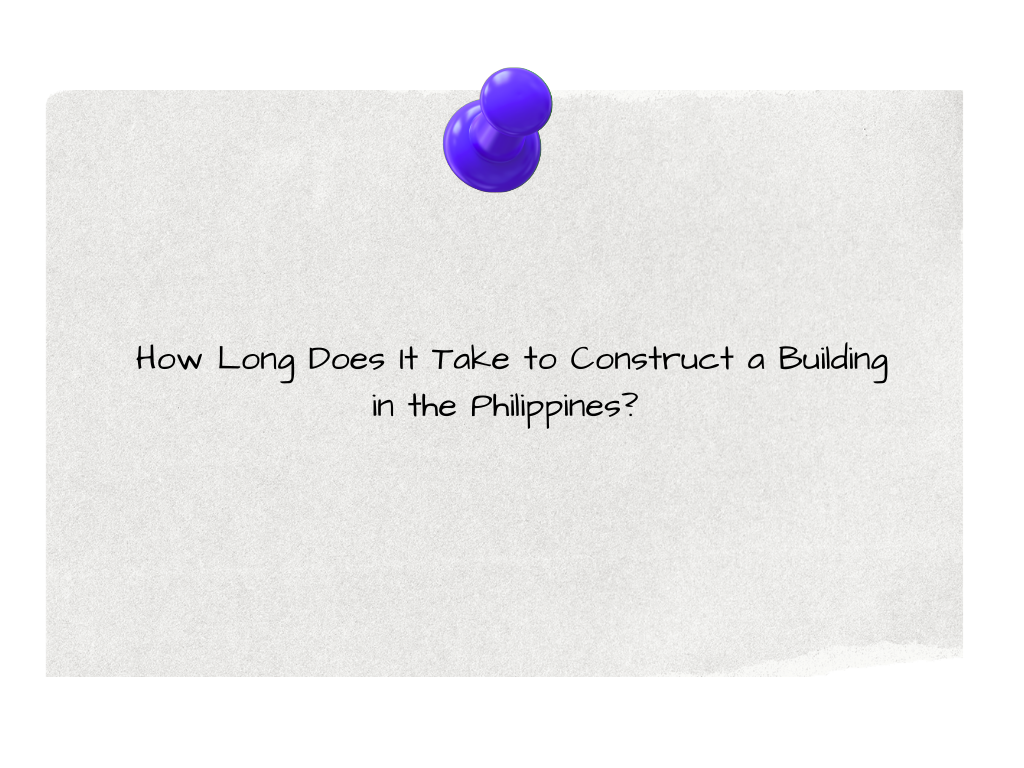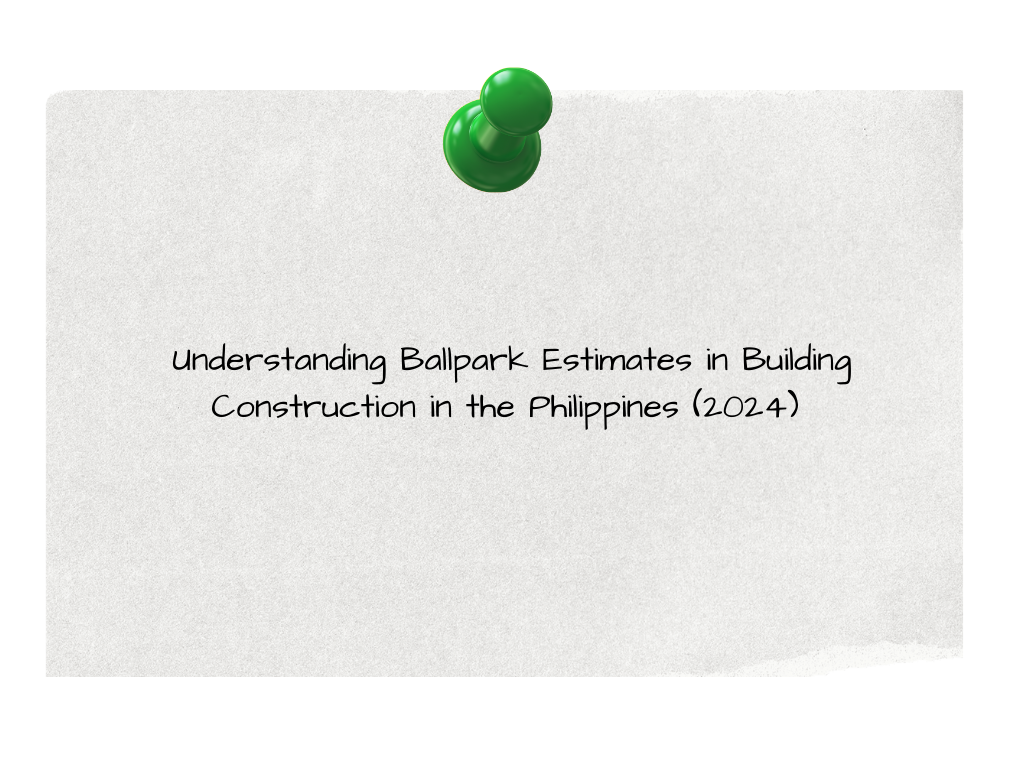Building a new structure is an exciting, yet challenging, endeavor. If you want a residential house, commercial building, or an apartment building, the first thing that you may ask is how long would it take to construct? In the Philippines, the time of construction is estimated to be completed which is due not only to the involvement of various aspects but also to the engineering, technology, construction model application, outsourced, in-house, or contracted performance.
This time, I will be sharing the average construction periods for various kinds of constructions in the Philippines for the year 2024 as well as details related to the elements that could bring about the construction time to finish a building.
Average Construction Time for Different Building Types in the Philippines
1. Single-Family Residential Homes
- Duration: 6 to 12 months
- Description: The construction of a standard, single-family residential home is usually the quickest and least complex type of building. In general, for a dwelling consisting of one or two stories with basic materials and finishes, it usually takes about 6 to 12 months from start to completion. This timeframe accounts for both the time required for securing permits, setting the foundation, building the walls, roofing, doing the interior finishing work, and final inspections, among others.
However, this schedule can be prolonged in cases when:
- The house becomes larger or more complicated.
- Custom materials or finishes are used as options.
- The construction site may be faced with unforeseen delays caused by bad weather or logistical issues.
2. Townhouses and Multi-Unit Residential Buildings
- Duration: 12 to 18 months
- Description: Townhouses or small multi-unit residential buildings (like low-rise condos) will usually take 12 to 18 months to be finished, subject to the number of units and the complexity of the invention. The schedule is composed of unit construction, common areas, and infrastructure, e.g., parking spaces, landscaping, and amenities. It also includes time spent creating pools and other related parts.
Duration deciding factors are:
- The size and quantity of the housing units.
- The level of manpower and material availability.
- The difficulty of services of common use (such as water, electrical facilities) and common areas.
3. Mid-Rise Buildings (3 to 8 Stories)
- Duration: 18 to 24 months
- Description: Mid-rise or multi-story buildings are buildings such as office buildings, mixed-use developments, or residential complexes with 3 to 8 stories that usually take 18 months to 24 to construct. These buildings are more complex due to their larger size and the inclusion of more intricate mechanical, electrical, and plumbing (MEP) systems, along with structural considerations for additional floors.
The following are factors that could lead to delays:
- More detailed planning and design, especially for MEP systems.
- Longer permit approval times.
- Coordination with multiple contractors responsible for different systems (e.g., HVAC, electrical, plumbing).
4. High-Rise Buildings (9+ Stories)
- Duration: 24 to 36 months (or a little bit more)
- Description: The construction of skyscrapers, commercial towers, and luxury condos, which are in the high rise category of buildings, continue to be the most time-consuming construction projects. It has been proven that the buildings which are the following usually require it within 24-36 months, or even more: height, design complexity, and location. The process of construction engages in more far-reaching planning, engineering, and coordination, especially for the structural systems, safety features (like elevators, fire escapes, such systems), and advanced MEP systems.
The following factors can impact the timeline for high-rise construction:
- The uniqueness and complexity of design (such as facade design and floor plans) are two of the factors affecting the height of the skyscraper.
- Appointing local workers and subcontractors having the qualification and proven experience for the particular task.
- Strict safety laws that also include expresses the buildings must have the ability to resist earthquakes as well as guarantees of fire safety compliance.
- Unfamiliarity with the kind of problem that may happen some traffic congestion cases like the lack of space for construction vehicles that may occur in the city centers.
5. Commercial Buildings (Offices, Malls, Retail Spaces)
- Duration: 18 to 30 months
- Description: In the development of commercial buildings such as offices, shopping malls, and retail shops, the normal construction period is between 18 to 30 months, depending on the size of the project. However, it is worth noting that the construction of these edifices is not only a matter of erecting buildings and opening spaces. It also includes the adaptation and installation of specialized systems like escalators, fire protection systems and airconditioning systems, besides the requirements for large open spaces and multi-story layouts. This process requires a higher degree of complication.
Factors influencing the construction duration include:
- The building’s size and number of floors.
- The need for specialized commercial features (e.g., elevators, HVAC systems).
- The fit-out process, where interiors must be tailored to the needs of tenants (retailers, offices, etc.).
6. Industrial Buildings (Factories, Warehouses, Plants)
- Duration: 12 to 18 months
- Description: In general, it takes 12-18 months to build industrial buildings such as factories, warehouses, and manufacturing plants, depending on their size, location, and design requirements. With the normal absence of more decorative elements in the buildings that are used by manufacturers or retailers, still, the initial works are significantly shorter, but industrial buildings/warehouses without load handling systems and other specialized equipment cause construction to drag on unnecessarily.
Delays may occur due to:
- Complexity in the installation of big mechanical devices or using specialized systems.
- Coordination of construction with ongoing operations (e.g., for operational factories).
- Problems with the supplying or shipping of large construction materials or machinery.
Factors That Affect Construction Time
These estimates, however, have to be understood as gross averages across different types of buildings and the actual implementation might take longer due to or benefit from the following factors:
1. Design and Permitting
- Design Changes: The more comprehensive and/or unique the architectural and engineering plans, the longer the design process may take. Moreover, any design changes that are made at the end of construction can have a huge impact on the time span.
- Permit Approval: Getting the construction permits is not a very easy task sometimes. In the Philippines, local government units (LGUs) require different clearances like zoning clearances, building permits, and environmental compliance certificates. Additionally, not having these permits can lead to the construction start date being pushed back.
2. Weather Conditions
- The conditions of the weather can be a source of inconvenience to the constructions, especially in the Philippines, during the rainy season that starts in June up to November. Strong downpours, typhoons, and floods can bring construction to a standstill, disrupt material delivery, or reduce the speed of the preparation of the site.
3. Labor and Material Availability
- Skilled labor and materials availability also have a significant effect on the time it takes to complete a building. Materials are not the only things that could be less available – construction skills and labor are also areas that could be scarce. Material shortages, labor strikes, or logistical difficulties are examples of causes that might lead to delays. This is particularly the case for big size or complicated projects which are specific and need to be carried out by various channels.
4. Project Management and Site Conditions
- Effective Project Management may choose the existing project and the right parties (contractors, architects, engineers) that will flow to complete the project and the project will be efficient and in time. Poor management can also be the case of delay as well as the reason for the budget overruns.
- It can be the construction site itself that raises issues, e.g., hard terrain, access problems, and pollution, that trap the traffic through construction.
Conclusion
In the case of the Philippines, there is a huge time range for the building in 2024 due to several aspects that are the type of the building, its complexity, and a number of external factors on the average:
- Single-family homes take 6 to 12 months.
- Mid-rise buildings are built in 18 to 24 months.
- High-rise buildings need 24 to 36 months or even longer.
It is very vital to hire a competent project team, to decompose the projects thoroughly, and to provide for the things that might go wrong. The time each construction project takes is unique, so these timeframes are only approximations, and project-specific factors will always be in place to determine the final completion date. Remember to incorporate a bit of flexibility and contingency planning into your building project in the Philippines when coming up with the expectations. Building a new structure is an exciting, yet challenging, endeavor. If you want a residential house, commercial building, or an apartment building, the first thing that you may ask is how long would it take to construct? In the Philippines, the time of construction is estimated to be completed which is due not only to the involvement of various aspects but also to the engineering, technology, construction model application, outsourced, in-house, or contracted performance.




One thought on “How Long Does It Take to Construct a Building in the Philippines?”